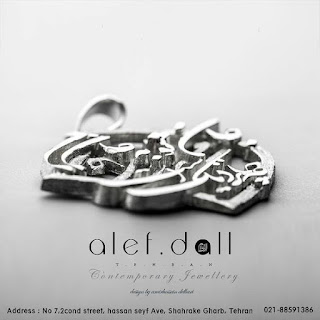 |
| Figure 2.5 - Delbari, A. H., (2010). Silver twisted pendant displaying Farsi Calligraphy |
 |
| Figure 2.6 - Hossein, A. D., (2010). Silver flat pendant displaying Farsi calligraphy |
Amir Hossein Delbari is an Iranian artist who incorporates Farsi/Arabic calligraphy to pottery, ceramic art and jewellery. In an article by Carlotta on her blog titled Splendor, she writes that Delbari started learning Farsi/Arabic calligraphy at the age of 9. During his teen years, he learnt pottery and began incorporating calligraphy into his ceramics. He went on to study Jewellery at university and again, incorporated calligraphy into his jewellery pieces.
His work in jewellery design often showcases Farsi/Arabic calligraphy. Farsi is a language similar to Arabic that is spoken in Iran. One popular style in Farsi calligraphy is "Nas'taliq" which I believe Delbari has used in most, if not all, of his Calligraphy pieces. Nas'taliq is a font of calligraphy that was created unintentionally by calligraphers while doing "rough practice writing". They would practice their writing by filling up a page with lots of writing, even allowing the sentences to overlap in some places. It was then recognized as an interesting style and was given the name Nas'taliq (Mirrazavi, F. 2009).
Delbari's calligraphy pieces are usually made out of just one metal (silver, gold or brass). These pieces have a rough/unpolished finish, where file marks, sawing cuts, blackening and porosity are left visible (see figure 2.6). I think that by leaving the pieces in this rough state, Delbari is attempting to mimic the same aesthetic as the Nas'taliq calligraphy font. I find the rough and unpolished look of his pieces fascinating. I think that it relates to the antique and used appearance of jewellery that I prefer over high polished/typical commercial jewellery.
It is also interesting to see that Delbari has created jewellery with calligraphy in a three dimensional way. Some pieces show alphabets that twist around to connect to the next (figure 2.5) or sentences overlapping each other (Figure 2.6), which may not create three-dimensionality, but does give the illusion of it. This technique is a unique way to turn something like calligraphy, that is originally completely two dimensional, into something three dimensional.
No comments:
Post a Comment